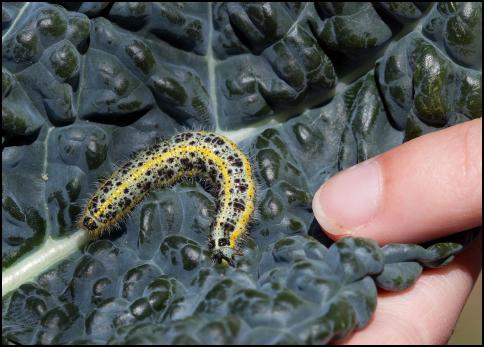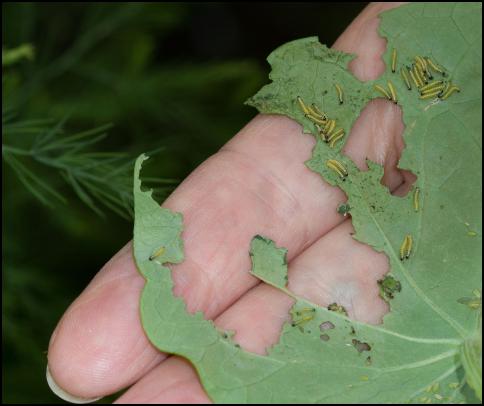Call for pest butterfly sightings: Richmond, Tasman, Nelson

A fully grown great white butterfly caterpillar
Call for pest butterfly sightings in Richmond, Tasman and Nelson
Householders in Richmond and other parts of Tasman as well as in Nelson city are being asked to look for great white butterfly caterpillars and eggs in their gardens following first reports of the pest in Richmond last week.
Great white butterfly caterpillars have been found at six Richmond properties to date.
Great white butterfly caterpillars and eggs are found mostly in clusters on plants they favour, particularly nasturtium, honesty and brassica vegetables, including broccoli and cabbage. The caterpillars are speckled black and greyish-green with three yellow lines along their bodies and the tiny, yellow eggs are in clusters of 30 to 100.
Sightings of the pest butterfly’s caterpillars and eggs should be reported to the Ministry for Primary Industries hotline 0800 80 99 66.
The Department of Conservation is leading a multi-agency attempt to eradicate the butterfly species, which was first found in Nelson city, in a bid to stop it becoming a major pest in New Zealand. It is a serious threat to commercial and home brassica crops, and to native cresses.
DOC Motueka Area Manager Martin Rodd said there had been a good response from Nelson Tasman residents to requests to look for butterfly infestations and report sightings.
‘We thank the Nelson Tasman community for its fantastic support for the great white butterfly eradication programme. We have now had more than 400 confirmed finds of it on properties since it was first discovered.
‘There has been a steady flow of calls over the holiday period as people have been out working in their gardens and have spotted the caterpillars and eggs on plants.
‘We’re also very grateful for the cooperation we are getting from householders for removing caterpillars and eggs and managing infestations on their properties.
‘With the first reports of the pest butterfly in Richmond we now want to determine the extent of infestations there and also to find out if there are any further out from Richmond.
‘We have been searching gardens of properties in the areas of those finds. We are also asking householders in Richmond and surrounding areas, as well as Nelson residents, to look for and report sightings of great white butterfly caterpillars and eggs to the MPI hotline 0800 80 99 66.’

Tiny, young great white butterfly caterpillars.
The eradication programme is being carried out by Nelson company Entecol Ltd under contract to DOC. Eradication entails physical removal of caterpillars and eggs and, as necessary, applying an organic insecticide to host plants.
Patches of nasturtium have been found to be major breeding hotspots where great white butterfly numbers have been rebuilding leading to them reinvading nearby properties. These nasturtium patches are being cleared or monitored for which property owners’ agreement is sought.
DOC has contracted Nelmac to clear nasturtium in steep, inaccessible sites, including where it is growing wild in public areas such as roadsides, with the agreement of Nelson City Council, and on private property. It is mostly being pulled out by hand but herbicide is being used with property owners’ agreement.
The multi-agency attempt to eradicate the pest butterfly was launched at the end of last year. It is being carried out in partnership with Vegetables New Zealand, MPI, Tasman District Council and Nelson City Council.
Great white butterfly identification information
The adult great white butterfly looks similar to the small white butterfly, though about twice the size, and it is easier to tell the difference between them by their caterpillars and eggs. The great white’s caterpillars and eggs are mostly in clusters whereas those of the small butterfly caterpillar are mostly found singly.
The great white butterfly caterpillar’s appearance changes through five growth stages. When very young, the tiny caterpillars are yellowish with a shiny black head. Then dark spots begin to appear on the body. In later stages, it is speckled greyish-green and black and has three yellow lines along its body. Larger caterpillars have lots of pale hairs and, when fully grown, are 50 mm long.
In contrast, the small white butterfly caterpillar is uniformly green with a faint yellow line along the top of its body and is about 30 mm long when fully grown.
–Ends–


 Gordon Campbell: On Abortion’s Role In The US Election
Gordon Campbell: On Abortion’s Role In The US Election The Treasury: Interim Financial Statements Of The NZ Govt For The Three Months Ended 30 September 2024
The Treasury: Interim Financial Statements Of The NZ Govt For The Three Months Ended 30 September 2024 NZ Labour Party: Labour, Greens And Te Pāti Māori Call On The Prime Minister To Block The Treaty Principles Bill
NZ Labour Party: Labour, Greens And Te Pāti Māori Call On The Prime Minister To Block The Treaty Principles Bill NZ Taxpayers' Union: Has Simon Watts Forgotten Who The Minister Is?
NZ Taxpayers' Union: Has Simon Watts Forgotten Who The Minister Is? Department of Conservation: Priority Conservation Projects Open For Donations
Department of Conservation: Priority Conservation Projects Open For Donations NZ Labour Party: Winston Peters Must Apologise
NZ Labour Party: Winston Peters Must Apologise Meat The Need: National Charity Auction To Combat Food Insecurity In New Zealand
Meat The Need: National Charity Auction To Combat Food Insecurity In New Zealand


